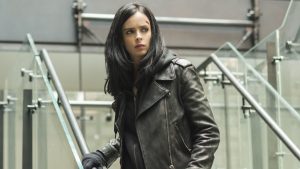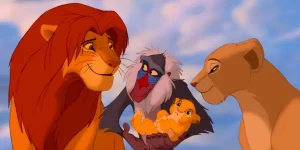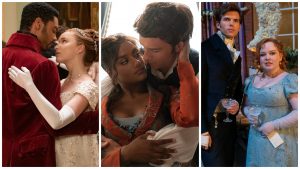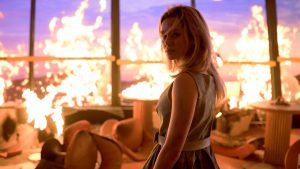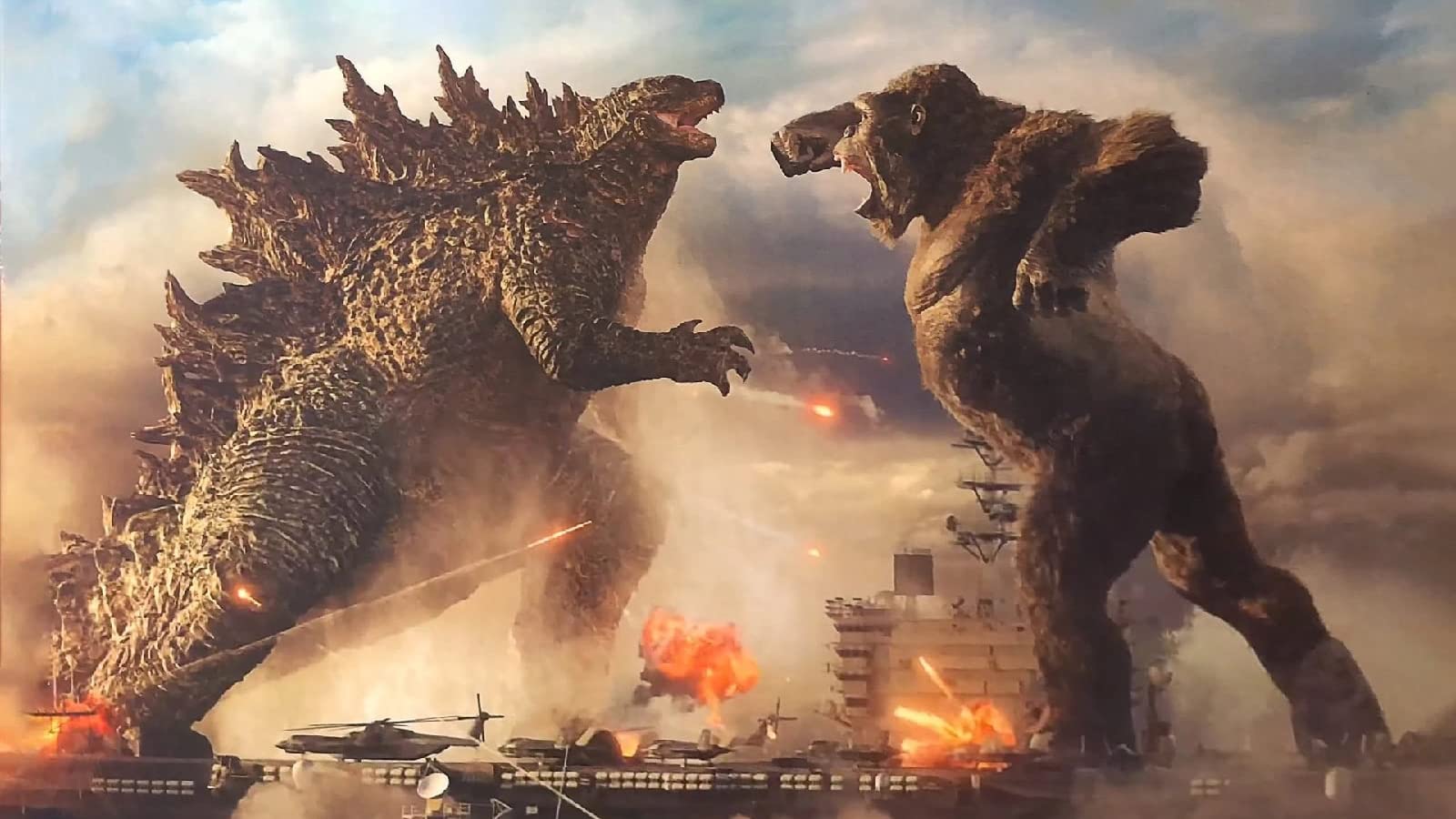
“King of the Monsters—Savior of Our City?” This is what a news channel chyron at the end of 2014’s Godzilla asks. The question appears on a television set in a San Francisco stadium that has been converted into a FEMA camp for survivors of Godzilla’s attack on the Bay Area, which climaxed with a battle between the Big G and two Massive Unidentified Terrestrial Organisms (MUTOs). The scale of suffering caused by these creatures, and the shrieks of terror the survivors let out when they see Godzilla rise after defeating the MUTOs and walk to the sea, tell us that the answer is “no.”
To anyone wondering who, then, is the savior of the city, the same scene provides an answer. In a sequence that mirrors countless feel-good videos shared on social media, we follow protagonist Lt. Ford Brody (Aaron Taylor-Johnson) in his tattered fatigues as he carries his son Sam (Carson Bolde) and searches for his wife Elle (Elizabeth Olsen), a nurse. Husband and wife catch sight of each other and rush together, meeting in the center of the frame to embrace as the strings of Alexandre Desplat’s score stir and soar.
The shot of a soldier and nurse coming together definitively answers the chyron’s question. America’s heroes, its first responders and military personnel, saved the city. In other words, the hero of Godzilla is not the awesome-looking monster but rather the dull as dirt humans. This problem has plagued all of the American Godzilla movies, from the 1956 re-edit Godzilla: King of the Monsters! to 1998’s Godzilla, to the MonsterVerse franchise. Time and again, American Godzilla movies put more attention on human characters instead of the monsters, which not only misunderstands what audiences want to see in a kaiju picture but also fundamentally avoids the tragedy that makes Japanese Godzilla movies so compelling.
The Exceptional Heroes of American Godzilla Movies
In the 2014 Godzilla’s standout scene, Ford and other paratroopers descend into the ravages of San Francisco. Director Gareth Edwards cuts from wide shots of the team floating through the clouds, their red smoke trails breaking the black and gray plumes that engulf them, and POV shots through Ford’s perspective. The team’s landing allows Edwards to demonstrate his greatest strength as a director, capturing the massive scale of Godzilla and the MUTOs. As Edwards swings his camera from Brody to Godzilla, a medium shot becomes a worms-eye-view shot, framing the humans as little more than rubble beneath the feet of the combatants above.
At least, that’s what one would think. Whatever Edwards’ visual language might suggest, the plot of Godzilla—screenplay by Max Borenstein, from a story by David Callaham—demands that the humans do matter, very much. While Godzilla and the MUTOs duke it out, the film instead follows Ford’s team as they destroy a MUTO nest and dispose of nuclear weapons that, they’ve come to learn, only make the MUTOs stronger. Despite its ability to capture the size of Godzilla and the MUTOs, Edwards’ film treats the human characters as far more interesting, repeatedly cutting away from the Titans to follow fleshy bores.
This problem is not unique to Godzilla, but plagues all of the MonsterVerse entries. As our own Kirsten Howard says in their review of the Apple TV+ series, Monarch: Legacy of Monsters, that show banks on audiences being “enthralled enough by the films’ central scientific organization that you’ll happily sit through an entire series about it as long as you occasionally get to see a titan or two in action.”
Of this franchise though, only Kong: Skull Island managed to reduce humans’ importance as secondary to that of the giant monsters. But director Jordan Vogt-Roberts’ glib approach made the disparity less of a thematic statement and more general mean-spiritedness. Likewise, Godzilla: King of the Monsters lets Ishirō Serizawa (Ken Watanabe) opine that humanity will become the pets of Godzilla, but the film believes that Mark Russell’s (Kyle Chandler) kvetching deserves as much screen time as King Ghidorah and Rodan.
To be fair, even the Japanese Godzilla films can get bogged down in human drama. Who among us thrilled at the familial tension between Goro and Rokuro Ibuki (Katsuhiko Sasaki and Hiroyuki Kawase) in Godzilla vs. Megalon, for example? But as that movie demonstrates, director Jun Fukuda, who wrote the screenplay from a story by Shinichi Sekizawa, had the good sense to realize that they matter only to the degree that they give us Jet Jaguar, who then gets to participate in the brawl.
Even the less goofy Japanese entries, including the most recent movies Shin Godzilla and Godzilla Minus One, make the humans interesting by reducing their individual importance in light of the titanic monsters. In the former film, human bureaucracy and incompetence allow Godzilla to destroy lives; in the more optimistic latter film, human community and interdependence allow them to save lives from Godzilla.
In Japanese Godzilla movies, humans matter because they can be harmed, because they’re so fragile. In American Godzilla movies, humans matter because they are exceptional and, almost always, American.
American Godzilla: A Legacy of Mistakes
We can trace that problem all the way to the first two films in the Japanese and American franchises. Director Ishirō Honda opens 1954’s Godzilla with sober white text on a black screen, set first to the thunder of the monster’s steps, then with the sound of Godzilla’s roar, and then with the desperate strings of Akira Ifukube’s score. Throughout the film, Honda pauses to let the camera linger on shots of people suffering, including the fisherman who witness the flash of light when Godzilla first surfaces, the villagers on Odo Island whose livelihood gets disrupted by the kaiju, or the woman in Tokyo who comforts her child in the face of death.
Contrast that focus to the approach in 1956’s Godzilla: King of the Monsters! The opening title card looks similar to the original’s credits, but it lasts only for a couple of seconds, without the score. Instead the movie jumps to coverage of destroyed Japan, as described by the U.S. version’s main character, reporter Steve Martin (Raymond Burr). Production companies Jewell Enterprises and Embassy Pictures put Martin forward in hopes that viewers will better identify with an American lead, with a handful of scenes shot in the U.S. with Burr being awkwardly inserted into a re-edited version of the 1954 Japanese film. However, the choice also centers an American as an exceptional figure among the chaos occurring in Japan. The movie begins by inviting viewers to ask what caused so much destruction, which is given a face when the building from which Martin files his report collapses. The film ends with Martin surviving the destruction and going to tell the story to the rest of the world.
Thus, even though Godzilla: King of the Monsters! features Dr. Kyohei Yamane (Takashi Shimura) identifying American H-Bombs as the source of Godzilla’s mutation—one of the few times the film retains dialogue from the original instead of changing the meaning or relying on Martin’s gloss—it quickly turns to an American hero for help. Unlike the military who dropped the bomb, the American reporter Martin will tell the truth, thereby saving Japan from a problem somebody else created.
The Heroism of the Lone Truth Teller
Although the 1998 Godzilla directed by Roland Emmerich does follow suit in some ways by making Dr. Nick Tatopoulos (Matthew Broderick) a truth teller who understands the danger of the U.S. military’s nuclear testing, the script by Emmerich and Dean Devlin admires the military too much to give the film any coherent point of view.
The 21st century MonsterVerse movies elide this problem by allowing individual soldiers to be heroic, even while condemning the larger U.S. military. The key conflict of the 1950s sections of Monarch: Legacy of Monsters pits Col. Shaw (Wyatt Russell) against his superior officer Gen. Puckett (Christopher Heyerdahl), who represents military bureaucracy. Similar moments appear throughout the MonsterVerse, from Lt. Brody fighting to eliminate the nuclear bomb that the army sent to San Francisco to the climax of Skull Island, in which former Air Force Pilot Hank Marlow (John C. Reilly) joins American reporter Mason Weaver (Brie Larson) and British Air Service Captain James Conrad (Tom Hiddleston) to stop the madness of Lt. Cl. Preston Packard (Samuel L. Jackson), a literal remnant of Vietnam determined to continue fighting a war he lost long ago.
In every MonserVerse movie, individual (and usually American) heroes stand against massive and shadowy organizations, whether they be more-or-less cut and dry villains, such as Apex Cybernetics in Godzilla vs. Kong or the eco-terrorists of Godzilla: King of the Monsters, or more ambiguous groups, such as Monarch or the U.S. military. Even when these organizations do something heroic, as when Monarch fights the eco-terrorists in King of the Monsters, the movie’s primary interest and sympathies lie with Mark Russell (Kyle Chandler), who clashes with the organization’s leaders. The MonsterVerse movies mistrust large organizations, putting their faith instead in small bands of individuals devoted to telling the truth.
That emphasis on individualism drives the MonsterVerse’s interest in conspiracy theories, something that begins with the opening credit sequence to the 2014 Godzilla. The opening credits appear over shots of historical archives about ancient monsters, military actions, and scientific tests. Each creative’s name appears as part of other text, which then gets covered with a bold line, replicating government redactions on official documents. The sequence ends with a shot of a mushroom cloud, presumably at Godzilla’s traditional ground zero, the island of Bikini Atoll, which draws a line between the U.S. military and the birth of Godzilla. However, the opening credits also work in references to Monarch in the documents, positioning this secret organization as also a power behind the scenes.
With the exception of Skull Island, which includes references to Monarch but also features footage of Vietnam War protests as obvious signifiers of its 1970s setting, all of the other MonsterVerse films follow Godzilla’s lead. Images of secret experiments blend with footage of real-world events and shots of the monsters, all overlayed with redacted text. Thus, its heroes—Lt. Brody, Mason Weaver, Mark Russell, Cate and Kentaro Randa (Anna Sawai and Ren Watabe) in Legacy of Monsters, and conspiracy podcaster Bernie (Brian Tyree Henry) in Godzilla vs. Kong—are people who uncover the truth. They stand out from the norms of society and the expectations of these large organizations. They are exceptional.
The Power of Powerless Protagonists
This emphasis on exceptional characters makes sense, given Western storytelling tropes, particularly in America. We like our stories to be about a person who struggles (the root word of protagonist and antagonist is the Greek agon, meaning to struggle), often against their fate. Given the emphasis on individualism in the U.S. and the fact that America used atomic weapons, it’s easy to see why our Godzilla movies would like to separate identifiable good guys from the military as a whole.
However, that emphasis on individualism simply doesn’t work when it comes to Godzilla films. No human being, no matter how complex, can compete with the pure spectacle of kaiju. Thus the sillier American Godzilla films, such as the re-edits of Japanese films, 1998’s Godzilla, and Godzilla vs. Kong (and likely the upcoming Godzilla x Kong) suffer because the movie keeps turning its attention away from the fun stuff to follow boring protagonists. Seriously, who wants to watch Millie Bobby Brown in the throes of teenage angst when we could be watching Godzilla and Kong duke it out?
But the problem grows worse in the serious American Godzilla movies, which want to make a larger point. King of the Monsters!, Godzilla (2014), and Legacy of Monsters all acknowledge that the United States made or revitalized Godzilla when they used nuclear weapons, but they also insist on focusing on American good guys who undo the evils of their sometimes misguided government. When Lt. Brody almost dies removing a bomb from San Francisco, when Weaver or Bernie report on the activities of the military or Apex and Monarch, when Lee Shaw argues against using bombs, the MonsterVerse entries place these lone heroic actions of greater importance than the widespread destruction the organizations (and, by implication, the U.S.) has committed.
Even the silliest of the Japanese films don’t take that approach. Even acknowledging the atrocities committed by Japan over the centuries, Nagasaki and Hiroshima are baked into the very concept of their Godzilla movies, and with it a keen sense of how life can be destroyed in an instant. When their humans don’t matter, it’s not just that they’re boring compared to Godzilla, Mothra, or Rodan. It’s that humanity is fragile compared to larger forces, represented by kaiju. The original Godzilla of 1954 still sets the stage for most Toho kaiju films, and in that classic no lone character is the real hero or protagonist. The original Dr. Serizawa (Akihiko Hirata) figures out a way to kill Godzilla at the end, but at the cost of his own life, which he sacrifices for the collective (and because refuses to allow the technology he made to kill Godzilla to fall in the hands of governments).
The American films refuse to let go of American exceptionalism. They insist that no matter what the country or its representatives have done, individual American citizens are fundamentally heroic. They stand outside the demands of society and their organizations. They are exceptional. And as a result, Godzilla from the U.S. are not only boring, they’re morally bankrupt.
The post Why Americans Can Never Get Godzilla Right appeared first on Den of Geek.
